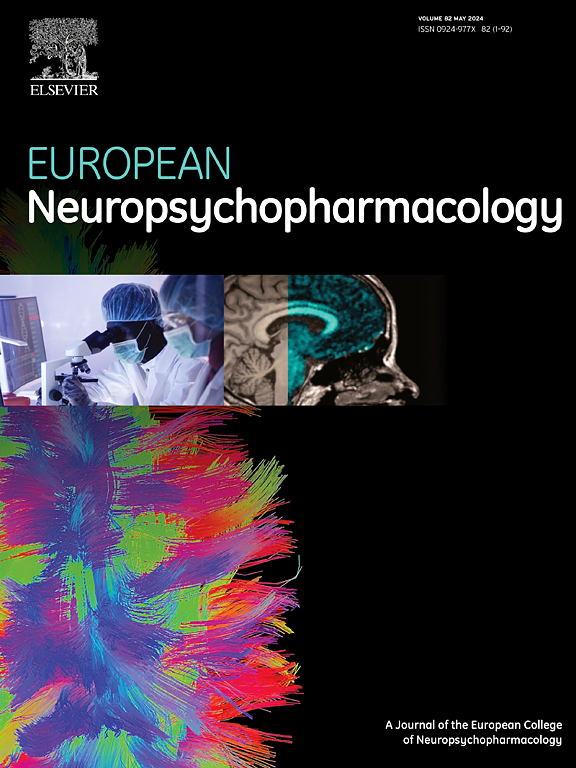Extrapyramidal symptoms as early clinical predictors in first-episode schizophrenia and schizophreniform disorder: findings from the OPTiMiSE trial
IF 6.1
2区 医学
Q1 CLINICAL NEUROLOGY
引用次数: 0
Abstract
Extrapyramidal symptoms (EPS) may occur as a primary feature in patients with first-episode psychosis with no or brief exposure to antipsychotics (AP). We aimed to analyse the prevalence of EPS in naïve and quasi-naïve first episode schizophrenia spectrum disorders (FES), their demographic and clinical correlates at baseline, and their association with clinical outcomes during follow-up. We analysed data from the OPTiMiSE trial, Phase 1 (n = 481 participants with FES, aged 18–40). The presence of EPS was defined as a score on the neurological side effects subscale of the UKU ≥ 1. We compared groups with and without baseline EPS in demographic, clinical and functional measures, and performed logistic and linear regressions models to analyse the associations between baseline EPS and clinical outcomes at follow-up. The prevalence of EPS at baseline was 30 % and was higher in women. There were no differences between AP-naïve or quasi-naïve participants. Participants with EPS showed a higher rate of depressive symptoms and suicidality at baseline. The fully adjusted models showed an association between the presence of EPS at baseline and more severe depressive, positive, negative, general and total symptoms, increased suicidality, and poorer subjective wellbeing and functionality at follow-up. Our findings support EPS as a primary feature of schizophrenia and suggest that early onset EPS (after no or minimal AP exposure) may point to a FES subgroup with poorer clinical prognosis. This suggests the role of EPS as an early marker of poor outcome, with the potential to guide targeted interventions in FES.
锥体外系症状作为首发精神分裂症和精神分裂样障碍的早期临床预测因素:OPTiMiSE试验的结果
锥体外系症状(EPS)可能是未或短暂接触抗精神病药物(AP)的首发精神病患者的主要特征。我们的目的是分析naïve和quasi-naïve首发精神分裂症谱系障碍(FES)中EPS的患病率,他们在基线时的人口学和临床相关性,以及他们与随访期间临床结果的关联。我们分析了OPTiMiSE试验1期的数据(n = 481例FES患者,年龄18-40岁)。EPS的存在被定义为UKU神经系统副作用亚量表得分≥1。我们比较了有和没有基线EPS的组在人口学、临床和功能测量方面的差异,并使用logistic和线性回归模型来分析基线EPS与随访时临床结果之间的关系。基线时EPS的患病率为30%,女性更高。AP-naïve和quasi-naïve参与者之间没有差异。EPS患者在基线时表现出较高的抑郁症状和自杀率。完全调整的模型显示,基线时EPS的存在与更严重的抑郁、阳性、阴性、一般和全部症状、自杀倾向增加、随访时主观幸福感和功能较差之间存在关联。我们的研究结果支持EPS是精神分裂症的主要特征,并提示早发性EPS(没有或很少接触AP)可能指向临床预后较差的FES亚组。这表明EPS作为预后不良的早期标志,具有指导FES有针对性干预的潜力。
本文章由计算机程序翻译,如有差异,请以英文原文为准。
求助全文
约1分钟内获得全文
求助全文
来源期刊

European Neuropsychopharmacology
医学-精神病学
CiteScore
10.30
自引率
5.40%
发文量
730
审稿时长
41 days
期刊介绍:
European Neuropsychopharmacology is the official publication of the European College of Neuropsychopharmacology (ECNP). In accordance with the mission of the College, the journal focuses on clinical and basic science contributions that advance our understanding of brain function and human behaviour and enable translation into improved treatments and enhanced public health impact in psychiatry. Recent years have been characterized by exciting advances in basic knowledge and available experimental techniques in neuroscience and genomics. However, clinical translation of these findings has not been as rapid. The journal aims to narrow this gap by promoting findings that are expected to have a major impact on both our understanding of the biological bases of mental disorders and the development and improvement of treatments, ideally paving the way for prevention and recovery.
 求助内容:
求助内容: 应助结果提醒方式:
应助结果提醒方式:


